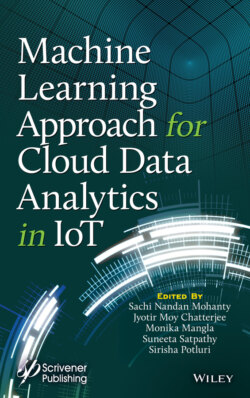Читать книгу Machine Learning Approach for Cloud Data Analytics in IoT - Группа авторов - Страница 77
2.7 Methodology
ОглавлениеIn order to integrate the technology approach, we can enumerate the equational approaches which are limited to opportunity by using them as defense against threat as there is no silver bullet. Be it any among the world’s leading business conducts that have their fortune counterparts, being crowned with cybercrime slows down the resource allocation process within the CPU for being a vulnerable threat.
Considering the next phase of work being threat detection and classification where machine learning algorithms play the major role of identifying with the model-based approach, the data sets are trained with patterns of malicious activities. When the data sets are put over the equations and tested within the axis, this presents recorded indicators that reciprocate to the real-time treats. This is where the unsupervised learning algorithm methodology of machine learning would find the interesting patterns in data sets, thereby identifying computer programs suggesting malwares and its associative crimes over cloud in terms of patterns using clustering and association algorithm. These derived learned patterns can be applied over IP bottleneck categorization, thereby further automating the procedural equation of deleting the trespassing of the system. It can also navigate throughout the cloud for identifying the behavioral patterns in DDOS attack.
The huge proliferation of machine learning techniques which highlights the analysis of multiple machine detection system hovering over the contextual topic is so called the cybercrime. Our studies have been put forth over to prioritize the cyber security resources with the co-relative approach of machine learning algorithm to determine which are linking networks involved in these certain types of attacks. It is really pros as it has been for the implementation of such algorithms that give rise to results based on network domain knowledge with the resultant values being data specific. Studies are based upon the use of anticipated usage of KNN algorithm for clustering the similar data to foster the enriched study with respect to IoT devices connected over the cloud. It is would definitely decipher to determine the cognitive analysis and reinforcement alerts over the network to subsidize the risk pondering over the association of smart thefts over various network attributes.
The resultant throughput of such a model can be referred to the pioneering act of intrusion detection, and protection of IoT devices can be carried out by machine learning models which aim at detection and segregation of similar ones into clusters and situations, preventing alterations of data during the testing phase. The algorithm used here can also get on to a regular system operation as of when applied over some data sets like (wine and viscos) which have proved to have made significant contributions in speech recognition, biometric systems, and so on. It automates complex cyber offences as well as defenses, powered by the learning models and their data sets, which act as a weapon to deal with the vulnerability of continuous intrusions, to stay forceful in combating the related issues as well as managing the network resource to balance the cloud content preferred with adversial use of cognitive artificial intelligence.
The synchronization of the spatial and temporal data from both ends and distribution of the power and bandwidth at both ends, i.e., of the IoT devices and there at the threshold of data server, is itself a high performance intelligent computation which desires to be providing the best of time complexity and space complexity. Each and every relationship established between the various components in IoT conglomeration has interchange of information which could be termed as best approach of cyber vulnerability as in reference to the context of being free from risk and secured in association to that of workforce inhabitants of the on possession of its access and its service.
The efficiency of cloud to receive and process it to get the information is virtually beyond limit. As it is more readily scalable intelligent algorithm, it has driven the authentication process in an enforcement of modality-based cyber metric captures and its facts of the cyber specification and just in time sharing mode; it is useful in automatically updating the information to identity authentication.
